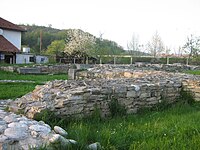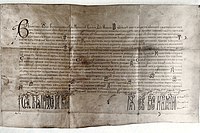Visoko during the Middle Ages

The area of today's Visoko is considered to be a nucleus from where Bosnian statehood was developed in 10th century.[1] The expanded valley of the river Bosna around today's Visoko was the biggest agriculture area in central Bosnia, so fertile ground around Visoko was ideal for development of early political center of Bosnian nobility.[2][3]
The settlement that was in Visoko field has been associated with the name Bosnia for a long time, only since the 1350s has the name Visoki became widely used.
History
Medieval settlement Bosnia
The first known
The place known as Bosnia is mentioned in 17 medieval sources. A number of documents in Latin mention Bosnia in the context of a settlement. Stephen II Kotromanić, Ban of Bosnia, wrote a charter in 1334 in Bossina in curia nostra. Ragusans wrote in 1367 about the location of St. Nikola church as conventus sancti Nicolae de Bosna.[8]
With times Visoki became a prevalent name for the medieval area that was known simply as Bosna (Bosnia).[9][10] Names for Visoko varied in literature: Vizoka, Uisochi, Vissokium, Vissochi, Visuki, Visochium.[11]
Bosnian banate

Bosnia had become a banate by 1154. The first domestic ruler was Ban Kulin. His plate was found in Biskupići (which is derived from biskup, meaning bishop), a small place just outside of Visoko. The plate was once part of a church built by Kulin. According to Pavao Anđelić[12] and others[13] the Bilino Polje abjuration took place in Visoko valley, instead of the field of Bilino near Zenica, as there are no records of significant settlement there.[14] Additionally Latin sources do not indicate where exactly this meeting took place, other than: by river, and that monastery is located beside town Bosna.[15]
The medieval settlement of Bosna (civitas Bosna) is mentioned in documents from the
Bosnian kingdom
The coronation of Tvrtko I Kotromanić was held on 26 October 1377 in the Church of St. Nicholaus in Mile. The Bosnian banate transformed into a kingdom. The fact this coronoation took place around Visoko has been proven archaeologically.[18] Tvrtko Kotromanić wrote to Hrvoje Vukčić Hrvatinić on 12 March 1380 out from the royal court in Moštre (Moištri in medieval sources), which was also located in the Visoko basin.
Political and trading center of Bosnia
The center of trade for the Bosnian kingdom was Podvisoki, which had a considerable colony of Ragusan merchants. From 1404 to 1428, Podvisoki was a frequent caravan destination. Milaš Radomirić was a prominent merchant from Visoko, later accepted as a citizen of the Ragusan Republic. On April 9 1428 the wedding engagement between
Struggle for power
King Ostoja died in 1418, which reignited unrest in the kingdom and eventually escalated into a civil war. Nobility once again didn't approve of the king, this time the son of Ostoja, Stephen Ostojić. He only had a handful of noblemen behind him, namely Petar Pavlović and Radosav Vladimirić. Stephen Ostojić ruled until June 5, 1420, when a meeting of the nobility in Visoko sealed his fate. The crucial event for Ostojić's demise was reconciliation between Radosav Pavlović and Duke Sandalj Hranić.
Tvrtko II reappeared around this time and he acquired the support of the Bosnian nobility in Visoko, including voivod Vukmir, mayor Dragiša, knez Juraj Vojsalić, knez Pribić, knez Radič Radojević of Pribinić-Radojević noble family, knez Batić Mirković, knez Juraj Dragičević, knez Petar Klešić, voivod Ivko and voivod Pavao Jurjević. Earlier that year the same nobility had supported Ostojić in one meeting that was held at the start of 1420, but this time Tvrtko II was assisted by the Ottoman Empire in reclaiming his throne and made Visoko his royal court in 1421.[22]
A meeting was held in Visoko with representatives of the
Fall of the Kingdom
Ottoman Empire by 1451 had a stronghold in Vrhbosna (today's Sarajevo) and Visoko was not safe anymore. Economic activity in Podvisoki faded and the king together with the nobility went into the north-east, where they retreated into better fortified positions like Bobovac and Ključ.[23]
In these twilight years of the Kingdom of Bosnia,
Visoko valley and notable centers
Visoki

The royal town of Visoki was a
Visoki was built on

Podvisoki
Podvisoki is a modern settlement in Visoko and was once a medieval subtown of the royal town. It was an important trade center and sometimes a ruler's residence. Podvisoki was one of the earliest examples of the medieval urban environments in Bosnia. In Podvisoki, a colony of Dubrovnik's merchants developed and maintained historically good relations with the Republic of Ragusa. The terms Bosnia and Podvisoki are often mentioned in Ragusan charters and documents, sometimes used interchangeably. Biggest caravan shipment in medieval Bosnia happened in 1428 between Podvisoki and Dubrovnik.
Mile
Mile was first recorded in 1244 as the home of the Church of
Visoko's museum houses many artifacts found by archaeological excavations in the valley. One such expedition found a stećak necropolis, some made in fine detail[clarification needed], including many materials, jewellery, tools, and other artifacts.
Moštre

There is not much detailed information about the
In addition to its university, Moštre was the location of
Milodraž
Milodraž, first mentioned in a charter
The settlement's significance was augmented by two royal weddings which took place in it: the wedding of Tvrtko II with
Pobrđe Milodraž, the present-day village in Kiseljak, Bosnia and Herzegovina, is located in the same area as medieval Milodraž.[26]
Other locations

In
In the small settlement of Malo Čajno, on the ground of an Orthodox church cemetery, a plate of big Kaznac Nespina was found. The stone slab depicts a relief scene of hunting with Romanesque stylistic characteristics. Its length is 210 cm, height 106 cm, and thickness is 7–10 cm. Cyrillic inscription reveals the title and name of the distinguished representative of the state administration whose task was to collect rulers revenues. Because of the carved relief there are indications that it is much older than the 13th century, as was originally believed, some experts dating it back to the 8th century.[27]
See also
- Old town of Visoki
- History of Bosnia and Herzegovina
- Bosnia and Herzegovina in the Middle Ages
- List of monarchs of Bosnia
- Bosnia (region)
- Bosnia (early medieval)
References
- ^ Filipović 2002, p. 203.
- ^ Anđelić 2004, p. 270-271, 284-285..
- ^ Mužić 2008, p. 32-33.
- ^ Vego 1982, p. 77.
- ^ Pavao Anđelić (Doba stare bosanske države, Visoko i okolina kroz historiju 1, Visoko 1984, 105)
- ^ Pavao Anđelić, Srednji vijek – Doba stare bosanske države, "Visoko i okolina kroz historiju I, Visoko 1984, 160–162
- ^ Teritorijalno širenje imena Bosna u pr vim stoljecima razvitka, "Studije o teritorijalnopolitickoj organizaciji srednjovjekovne Bosne", Svjetlost, Sarajevo 1982, 31-34
- ^ Anđelić 1973, p. 231-232.
- ^ "Gdje je bio podignut prvi franjevački samostan u srednjovjekovnoj Bosni", Prilozi. Institut za istoriju u Sarajevu, XX, 1985, br. 21, str. 95—114, posebno str. 106—114.
- ^ Brković, Milko (2009-06-10). "Povelja bosanskog kralja Stjepana Ostoje iz godine 1417". Radovi. Razdio Povijesnih Znanosti / Sveučilište U Splitu. Filozofski Fakultet Zadar (in Croatian). 26 (13): 225–235.
- ^ dr. Julian Jelenić, Kraljevsko Visoko i samostan sv. Nikole, Sarajevo, 1906
- ^ Škegro 2005, p. 363.
- ^ Milko BRKOVIĆ, Diplomatičko-paleografska analiza bolinopoilske isprave iz 1203. godine. Prilozi: Institut za istoriju u Sarajevu, 32. (2003.) 49.-74. Petar RUNJE, Pokornički pokret i franjevci trećoredci glagoljaši (13.-16. st.). “Provincijalat franjevaca trećoredaca” - “Kršćanska sadašnjost”, Zagreb, 2001.
- ^ HADŽIJAHIĆ, 1973.: 427.-438.
- ^ Runje 2001, p. 18.
- ^ P. ANĐELIĆ, Bobovac i, 231-234.
- ^ a b "Komisija za očuvanje nacionalnih spomenika". old.kons.gov.ba. Retrieved 2019-05-07.
- ^ Anđelić 1979.
- ^ Mustafa Imamović, Osnove upravno-političkog razvitka i državnopravnog položaja Bosne i Hercegovine, Pravni fakultet Univerziteta u Sarajevu, Sarajevo (2006), str. 46.
- ^ Jelenić 1906, p. 29.
- ^ Jelenić 1906, p. 33.
- ^ Jelenić 1906, p. 37.
- ^ Jelenić 1906, p. 50.
- ^ a b Sarajevu, Institut za historiju-Univerzitet u. "Pejo Ćošković - Crkva bosanska u XV. stoljeću".
{{cite journal}}: Cite journal requires|journal=(help) - ^ "Komisija za očuvanje nacionalnih spomenika". old.kons.gov.ba. Retrieved 2019-05-28.
- ^ a b c Regan, Krešimir (2000), Bosanska kraljica Katarina (in Serbo-Croatian), Breza, p. 40
- ISSN 0350-0020.
Sources
- Desanka Kovačević-Kojić, Sarajevo (1978). Gradska naselja srednjovjekovne Bosanske države
- Bešlagić, Šefik (2004), Leksikon stećaka, Svjetlost, Biblioteka kulturno nasljeđe Bosne i Hercegovine, ISBN 9789958107511
- Mužić, Ivan (2008), Vjera Crkve bosanske, Muzej hrvatskih arheoloških spomenika
- Škegro, Ante (2005), Fenomen "Krstjani" u srednjovjekovnoj Bosni i Humu, Institut za istoriju u Sarajevu;Hrvatski institut za povijest, Zagreb, ISBN 978-9985-9642-5-5
- Runje, Petar (2001), Pokornički pokret i franjevci trećoredci glagoljaši, “Provincijalat franjevaca trećoredaca” - “Kršćanska sadašnjost”, Zagreb
- Brković, Milko (2002), Srednjovjekovna Bosna i Hum. Identitet i kontinuitet., “Crkva na kamenu”, Mostar
- Filipović, Milenko S. (2002), Visočka nahija, Mak, ISBN 9789958977701
- Anđelić, Pavao (1973), "Bobovac i Kraljeva Sutjeska, Sarajevo", Informatica Museologica, 6 (29): 8–0
- Anđelić, Pavao (1984), Doba stare bosanske države, Visoko i okolina kroz historiju 1, Visoko 1984, 101-309, lat., Skupština Općine Visoko
- Anđelić, Pavao (1979), Krunidbena i grobna crkva bosanskih vladara u Milima (Arnautovićima) kod Visokog (in Serbo-Croatian)
- Vego, Marko (1982), Postanak srednjovjekovne bosanske države, Svjetlost
- Ćošković, Pejo (1996), Veliki knez bosanski Tvrtko Borovinić, Croatica Christiana Periodica XX/37, Zagreb
- Jelenić, Julian (1906), Kraljevsko Visoko i samostan sv. Nikole, Daniela A. Kajona, Sarajevo
